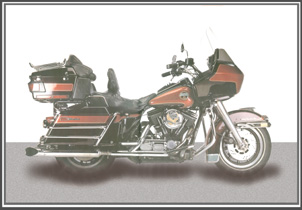
1990

1990 FLTC Ultra-Classic
With the "luxury riding" market growing and becoming stronger, long distance riding in comfort and style, was creating more requirements by riders for the company to meet. More attention was given to the passengers, along with the riders, for the company to meet the requirements of luxury and style and produce more deluxe motorcycles. A lot of the after market accessories and products became expected standards in following though in the direction of plush and comfort. Seat heights, backrests, footboards, grab rails, armrests, and seat shapes were all studied and re-designed to make riding a more comfortable experience for the passengers for long distance touring, and more comforts were being built and added to meet the passengers requirements. The 1990 Ultras had silver and black paint schemes, Ultra Classic name plates on the saddlebags and front fenders, and circular graphics on the tanks. All the new touring models got a high-output alternator, self canceling turn signals, and new gas tank designs. The luxury touring market's main focus was comfort, convenience, and adding touches of plush design were-ever possible, while at the same time making the touring bikes as dependable as other bikes in the line-up, and maintaining the number one standing in the luxury and touring motorcycles. The clutch was made stronger and tougher and attention and adjustments were given to the cruise control.
The 1990 FLTC had a 81.65 cubic inch engine displacement, 3.5 x 4.25 inch bore and stroke, 5 speed transmission, compression ratio of 8.5:1 and put out 55 horsepower. It came with duplex chain primary and belt final drive, dual disc front, and disc rear brakes, a 12 volt battery, 38mm Keihin carburetion, and CDI ignition. The frame was steel double down-tube with telescopic fork front, and dual shocks rear suspension, MT90-19 front, MT90-16 rear tires, a 5 gallon fuel, 3 quart oil capacity, weighing780 pounds with a wheel base of 63.1 inches. Dark hi-fi blue, vivid black, candy hi-fi blue, and ruby/candy ruby were the color schemes for 1990, of which 3,082 were built. The top speed for these machines was 110 miles per hour and they sold for $13, 695. The heavy loads could be slowed down from a comfortable distance with triple disc brakes, and a large travel trunk and saddlebags could carry enough gear for both the rider and the passenger, making it convenient for two people to be on the road for extended periods of time while being able to have what belongings along with them they chose for travel. The rider and passenger both had comfortable seats, with the the riders backrest being removable. The Tour Glide looked little changed as far as major changes, but the newer upgraded luxury packages and the new Evolution made quite a difference. With all the luxury components, the FLTC was known as the 'flagship' of the long distance touring machines.
The Electra-Glides clutch was beefed up this year, and the cruise control given some fine adjustments. The Electra-Glide continued out-selling the Tour-Glide better than five to one. The Electra-Glide, had it's traditional bar mounted fairing and small windscreen. The Tour-Glide, with it's frame mounted fairing, starting to pick up in sales the following year, with some credit being given too the company's demonstration ride program at major rallies, it being a newer model.
A fair amount of the bar-mount fairing site closer to the rider, blocking little of the view immediately ahead of he rider. The larger unit seemed a little like an obstruction at first, in comparison, to maneuver at low speeds, though the ride is quieter, helps to reduce fatigue on long rides, and offers much better wind protection once out on the open road. The first experience for riders not accustomed to full fairing, is awkward. Once used to the fairing, most riders don't mind it's presence and consider it a basic part of the bike worth getting used to for the extra wind protection.
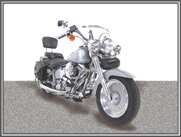
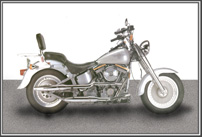
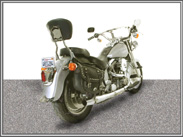
1990 FLSTF Fat-Boy
The FLSTF, 'Fat Boy' came along this year which brought the entire realm of nostalgic history back with components of the Heritage Softail Classic and Softail Custom. The 'Fat Boy' came to be as a re-touched Heritage Softail. Modified to achieve a certain look, combining the new with the old to create an entirely new motorcycle, was the new FLSTF's purpose.
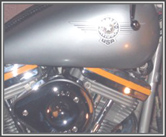
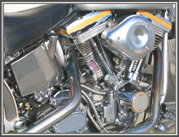
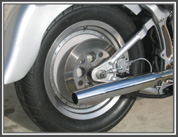
The FLSTF had a 81.65 cubic inch engine displacement, 3.5 x 4.25 inch bore and stroke, 5 speed transmission, duplex chain primary, belt final drive, disc front and rear brakes, 38mm Keihin carburetion, 12 volt battery, CDI ignition, 8.5:1 compression ratio, and 55 horsepower. The frame was steel double down-tube, telescopic front, shocks front suspensions, 4.7 fuel capacity, 3 quart oil capacity, MT90-16 front and rear tires, a 62.5 inch wheelbase, weighing 665 pounds. Metallic silver was it's color scheme, and a top speed of 114 miles per hour. 4,440 of these machines wee built which sold for $10,995. The touring style and luxury became a well set and re-stated standard by the '90s. The 'Fat-Boy' design and introduction caught on quickly. The 'Fat-Boy' was destined to become a collectors item among biking enthusiasts and achieved that status. It's said, by some that the name derived from 'Fat Man' and Little Boy' in relation to Nagasaki and Hiroshima. Also, in 1990, construction on a 31 million dollar state of the art paint facility started in York, Pennsylvannia, which was finished the following year. With the company's introduction of the Fat-Boy, and it becoming an instant success, Harley Davidson, once again became the leader in the heavyweight (over 750) market. The new Dyna Glide series is launched with a Sturgis model to commemorate the 50th Anniversary if the Black Hills Classic in Sturgis, South Dakota. Attendance at this rally, exceeded 250,000. The 1990 introduction of the FLSFT, 'Fat-Boy', was a pretty big deal and the motorcycle was considered a classic among Harley Enthusiasts.

Buell RR 1200
Also this year came the Buell RR 1200. Erik Buell, a former road racer and was part of the design team that helped create the FXR rubber-mount chassis. Formerly with Harley-Davidson, though he left in 1985 to build racing motorcycles, one of which had been the RR-1000. The Buell chassis is a birdcage frame of chrome-moly tubing which a sportster engine in mounted by a four point mounting system. Most of the hardware is handmade including the Buell-designed four-piston brakes. The mounts use rubber dampers and Heim-joint rods to absorb the V-Twins vibrations. A Works Performance shock absorber, mounted below the engine, dampens the rear wheel, and a fork from Marzocchi suspends the front end. The exhaust pipe was routed beneath the engine. The wheel rims were provided by Performance Machine, with spoke design and hubs by Eric Buell. Much of the hardware was handmade for the sport bike, including the four-piston front brakes. Much of the outer body work was done away with in some of the following years. The engine mounts used rubber dampers and Hemi-joint rods to absorb any vibrations.
1991
In 1991, a $31 million dollar facility was built for painting purposes in York, Pennsylvania. This helped the company grow as the need for motorcycles goes into an all time high. All Harley Davidsons change to a five speed transmission this year. The Dyna line of Harley Davidson was introduced with the FXDB Dyna Glide Sturgis.

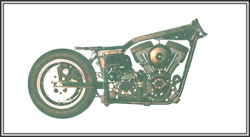
FXDB Dyna-Glide Sturgis Chassis - Dyna - FXR
The Sturgis was in the line up for '91. The Dyna-Glide chassis put the engine further forward in the frame and was tilted 4 degrees back. The oil tank fit underneath the transmission. The Sturgis, with a new evolution engine and a new chassis this year had the rider sitting at just 29 inches from the ground. This version of the Sturgis, as a third generation Low Rider, was another limited edition model, built only a single year with a production number of 1,546 machines. The Sturgis styling had gained enormous popularity in it's earlier years, and the chance was given this year to present it in an improved form. The square section frame backbone runs from the steering head to the swing-arm pivot with an engine mounting system using two instead of four rubber mounts. The belt drive system had been improved and simplified since it's first introduction and it now included a new drive sprocket retainer that had a better retention. The re-born Sturgis served as good platform to introduce the Dyna Glide chassis, and to satisfy all the requests to offer the model once again. To look at it, it resembled the original first Sturgis' in many ways, but but now there were differences that appeared in the final details. The Dyna version got only one disc brake in front, though both, the new seat and handlebars were higher than the old older one. Both weighed 610 pounds though an inch more wheelbase. It ran longer between tune-ups, was more comfortable, and smoother on longer trips. The cost was more at 11,520.00 where the older ones from ten years older were 5,687.00. The FXDR Sturgis was the first Harley Davidson built using the computer-aided design. The Dyna Glide chassis situated the engine farther forward in the frame and tilted 4 degrees back, and had the oil tank fit beneath the transmission.
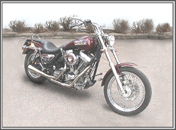
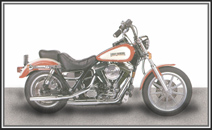
1991 FXR 1991 FXRS
The FXRS Low-Rider had established itself, as the most popular model on the Super Glide line up. After 15 years, and many upgrades, it was still the King of the Cruisers. The Super-Glide, Low Rider family, had grown to six models. A general consensus was held that the FXR Sport was the best handling and most versatile of all the big Harley's. The FXRS Low Rider remained the number one in the family, with the Custom and Super-Glide following next. The Sport model, running third, had it's longer suspension. The FXRS, was basically, a Sport model with a adjustable and detachable windshield and quick-release saddlebags. This dual type function, would come to be used in years to come on the FLHR Road King. Considered a sport - touring motorcycle that could easily adapt to either end of the functional intent. It had less comforts than some of the larger dressers, though more motorcycle than the smaller Sportster.
1992
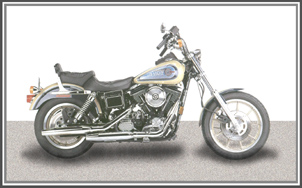
1992 FXDB Daytona
The Daytona, named in honor of the 50th anniversary of the Daytona 200, and the next model to use the Dyna Glide chassis as another limited edition, the 1992 FXDB Dyna Daytona came with a 81.65 cubic inch engine displacement, 3.5 x 4.25 in bore and stroke, 8.5:1 compression ratio, with 72 horsepower, 5 speed transmission, 40mm Kelhin carburetion primary duplex chain, belt final drive, with dual disc front, and disc rear brakes. It had a 12 volt battery, CDI ignition, steel double down-tube frame, front telescopic fork, rear shock suspension, weighing 630 pounds with a 65.5 wheelbase. The fuel capacity was 4.9 gallons, 3 quart oil capacity,100/90-19 front, 130/90-19 rear tires with a top speed of 103 mph. Gold pearl glo/indigo blue metallic were the color schemes. The Daytona's two tone paint schemes were the first "True Pearl Paint". The engine was black and chrome. 1,700 of these were built and sold for the price of $12,120.00. Though not released until 1992, the Daytona shared it's running gear with the Sturgis though carried dual disc brakes in front.
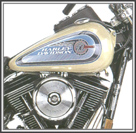


The rear drive pulley and cast wheels were painted gold. The tank featured the 50th anniversary graphic and there was an inscription on the air cleaner that noted the Daytona's exclusive year. The Daytona got the company's new self canceling turn signals and horn loud enough to get car drivers' attention. The Daytona's exhaust crossover pipe was hidden away nicely below the transmission. and the electrical components were hidden in a chrome-capped box under the seat's left side were the oil tank fit previously. The battery was cased in chrome, though was still in the same place on the right. Also other modifications included continuous venting for the two fuel tanks ensuring constant fuel supply to the 40mm carburetor. The next version, the FXDC custom shared all the components of the Daytona, but was painted metallic silver and black, with a silver powder-coated frame. Te custom's engine was left unpainted.
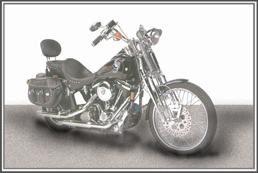
1992 FXSTS
1992 FXSTS - Low Rider had established itself as the most popular model on the Super Glide line-up. The Super Glide/Low Rider family had grown to six models. Followed by the Custom, and Super-Glide, the Low-Rider held as the most popular member of the family. The Sport model, with it's longer suspension travel, ran a distant third, with the Convertible matching numbers with the standard FXR's production. The convertible, basically a sport model with adjustable/detachable windshield and quick-release saddlebags, Milwaukee's rendition of a sport-touring machine, with more capacity and amenities of the Sportster, and fewer long-haul comforts than the Electra-Glide. The dual-function option, would later be used in similar fashion for the FLHR Road-King. The oil filter was re-located to the front of the engine for better access for the FL's this year. New materials were added to the disc rotor and brake pads this year, which had a better feel at the brake lever, and better gaskets were added to the saddlebags, to ensure a dryer wet season.
1993
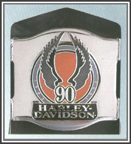
90th Anniversary Emblem
For 1993, the Dyna's evolved as the FXDL Low Rider and FXDWG Wide Glide. The 1993 FXDWG came with the 81.65 cubic inch engine displacement, 3.5 x 4.25 inch bore and stroke, 8.1:5 compression ratio, 72 horsepower, 5 speed transmission, 38mm Kelhin carburetion, with duplex primary belt final drives. Dual disc front and rear disc was the braking combination, and a 12 volt battery and CDI ignition, steel double down-tube frame telescopic front, and shock rear suspensions, with a wheelbase of 66 inches. Weighing 615 pounds the fuel capacity was 5.2 gallon, with a3 quart oil capacity. The tires were MH90-21 front, and 130/90-16 rear. Vivid black: victory red/sun-glo; aqua sun-glo/silver were the FXDWG's color scheme for 93, with 5,602, (including 1,993 Anniversary), built, a top speed of 110 miles per hour. The FXDWG cost $12,550.


1993 FXDL - Dyna Low-Rider 1993 FXDWG - Dyna Wide Glide
The Wide Glide returned with the Dyna chassis and evolution just as the Sturgis was reborn in updated form. The fat bob format was apparent in the wide (fat), fuel tank, and trimmed (bobbed), rear fender. The Wide Glide represented a salute in recognition to the kicked-out, laid-back, Easy-Rider style of chopper revival of twenty years prior. The commemorative model FXDWG Dyna Wide-Glide, with it's thirty-two degree fork rake, 21 inch front wheel and trademarked Ape Hanger handlebars, it was a fat bob re-visited. The FXWDG , not the most comfortable, in comparison, for long rides, was just right for the cruising the boulevards and back roads, with new motor and support plates brought less vibration and a smoother ride. The limited Anniversary editions were all fitted with serialized nameplates, "jeweled" cloisonne fuel tank emblems, and two tone silver/charcoal satin-brite paint schemes. The bobtail rear fender had a tucked in tail-light, slim front fender, which sat back in an 8 inch gap between the fork tubes, accounting for the Wide Glides wideness. It had a forward mounted front shifter, and brake levers and a pillow soft seat. The forward mount foot controls allow the laid-back riding position that was needed for the cruising in easy chair style. The FXDWG special production was limited to 1,993 motorcycles.
Harley Davidson marked its 90th birthday with a major celebration in Milwaukee. Also with the coming of 1993, came six Anniversary Edition motorcycles. On June 12, 1993, riders converged in Milwaukee for a festival to commemorate the company's 90th anniversary and a family re-union parade. More than 100,000 enthusiasts came for the event, highlighted by an eight-mile long parade featuring 60,000 Harley-Davidson motorcycles.
The Springer wasn't chosen to carry anniversary edition status in 1993, but, in response to continued urging, it got a front fender that more closely conformed with the tire. The new fender attached by chromed dog-bone links to the sprung yoke, so fender moved with the wheel. A new, more tapered headlamp was added to complement the Springer's suspension hardware.


1993 FLHTC Electra-Glide Ultra Classic Anniversary model
Another of the six Anniversary Limited edition machines was the FLHTC Electra-Glide Ultra Classic, of which 1,340 were made. A new automotive-style cruise control, with a tap-feature for raising and lowering speeds was introduced, and a new American-made CB radio was included. The silver/gray/black paint, cloisonne tank emblems and serialized nameplate the Anniversary model a $16,099 price tag. The new oil pan below the engine, allowing better cooling of oil and a lower center of gravity was seen on all the new touring machines. This helped with the simplicity of maintenance with a dipstick for checking the oil. The FLHTC Ultra Classic's engine displacement was 81.65 cubic inch, 3.5 x 4.25 bore and stroke, 8.5:1 compression ratio, having 72 horsepower at 4,000 rpm. This and the 38mm Kelhin carburetion, a 5 speed transmission, duplex chain primary, belt final drive, dual discs front, disc single, a 12 volt battery with CDI ignition was sitting on a steel double down-tube frame, front telescopic front, shocks rear suspension, weighing 774 pounds with a 62.9 wheelbase. The fuel capacity, was 5 gallon, with a 4 quart oil capacity, MT90 - 16 front and rear tires. A top speed of 110 miles per hour came with the FLHTC, with two tone aqua sun glo/silver, two tone victory red, sun/glo silver, and vivid black; victory red sun-glo, as paint color schemes. 3,702 of these were built, and came with a price tag of $15,349. A jumbo six travel trunk that opened sideways, hinged on the left as an Electra-Glide optional accessory, flexible antennas for radio and CB radio attach at the trunks corners. The saddlebags gained 15 percent more capacity for the year, also, with the battery now under the seat, it no longer broke into space of the right saddlebag. New lockable latches operate with the same key used for the ignition and fork lock. The air-suspension system, allowed air pressure settings to be changed to suit loads and road conditions. The Electra Glide's large travel trunk is hinged on the left, so that it opens sideways, (right to left). Flexible antennas for radio and CB radio attach at the trunk's corners. The saddlebags gained an increase of inside capacity of 15 percent for '93. New lockable latches worked with the same key as the ignition and fork lock. With the battery being under the seat, it no longer took space from the right saddlebag. The passengers seat is fitted with arm rests, and the riders backrest was detachable. The passenger also had their own stereo speakers, and separate radio controls, all shielded from the weather and elements by the fairing.
The Ultras, both Tour and Electra Glide, shared with the rest of the FL series, an air suspension system at both front and rear. Air pressure settings at both ends could be balanced to accommodate varying road conditions and loads. The tourers also got he 'dog-leg' brake and clutch levers, which gave easier reach and better feel. Also, the battery, previously housed in the saddlebags, got a new position, below the seat. The guard rails surrounding the saddlebags were re-designed for both appearance and strength, and the saddlebag lids, now attached permanently, got new hinges and a nylon tether. The instruments and radio were shielded from the weather's elements by the fairing. The sound systems controls were fitted to the handlebars. The passengers seat was outfitted comfortably with armrests, stereo speakers, and separate radio controls, and arm rests, and the riders back-rest was detachable.


1993 FLSTN Heritage Softail Nostalgia
The 'Big Week' run at Daytona Beach, was the first time the Heritage Softail Nostalgia was shown to the public. With the natural cowhide inserts on the seats and saddlebags, it immediately picked up the nick-name of the Cow-Glide. The wide Dunlap whitewall tires on wire wheels and the black and white paint scheme, complimented the theme of bovine motif. The Softails shared a lot of the improvements in engineering of the controls and drivelines of the other models. The FLSTN shared the Fat-Boy's 'shotgun' dual exhausts, The Nostalgia was the only non-Anniversary model to wear the chrome and fired-enamel cloissone tank emblems. Also a limited edition the company produced 2,200 Nostalgias for 1993. The Heritage Softail didn't have some of the touring requirements of the Electra-Glide Ultra Classic, but was a little bit faster, 55 pounds lighter, and not quit as expensive. With the two-tone paint and studded seat and saddlebags, the Heritage Softail Classic had all the vintage character of the '50s and it was easier to handle around town. Harley Davidson became half owner of the Buell Motorcycle Company. In 1993, Harley Davidson celebrates it's 90th anniversary in Milwaukee with a family reunion parade.
In 1993, Harley celebrates its 90th anniversary in Milwaukee with a family reunion parade, where an estimated 1 million Harleys are ridden.
1994 saw the jump of Harley-Davidson into the Superbike racing with the VR1000. The VR1000 featured a dual overhead cam and a liquid cooled engine and showed that Harley-Davidson was not fully averse to manufacturing a race inspired sport bike.
1994

VR 1000
The first pure racing motorcycle Harley Davidson ever built, debuted this year. The 1994 VR 1000's engine was a dual overhead cam, liquid cooled 60 degree V-twin, with a 61 cubic inch engine displacement, four valves per cylinder, a 3.86 x 2.6 inch bore and stroke, a 11.6:1 compression ratio, producing 135 horsepower at 10,000. Every other racer, from 1915 through 1993, was a modified production machine. The VR, was built for the purpose of racing from the ground up. The VR 1000 came with a Weber EFI fuel injection, 5 speed transmission, multi-disc dry clutch, gear primary and chain final drive, dual disc front, and disc rear brakes, and electronic ignition. Harley Davidson had never felt comfortable with the building of pure-bred competition machines, though their being brought into the racing scene eighty years earlier did it's part of showing the company the racing scenes captivating audiences. Since the sports enthusiasts from the years 1910 and 1920, the racing department proved itself a continuing source of encouragement and team spirit. Fans rode their machines the races to support their favorite manufacturers and riders. The company held a dirt and track profile through the years with different models and built a few production based racers. The VR 1000 had an aluminum 2-spar perimeter frame, inverted front and single shock rear suspensions, a wheelbase of 55.5 inches weighing 390 pounds, with a fuel capacity of 4.5 gallons, and a 3 quart oil capacity, and reached a top speed of 170 miles per hour. It came with Dunlop 120/70ZR17 front, and 150/70ZR17 rear tires with an orange and black color scheme. 50 of these machines were built and brought a price of $49, 490.00.

Large, over size rotors, and six-piston Wilwood brake calipers were used to help to slow the bike down from it's 170 miles per hour. Most of the body work was constructed of light, and expensive carbon fiber, and though it was outfitted for civilian use, the riding position re-enforces the racers crouch. Road and other riders, preferred the higher handlebars, and kicked back positions that the other bikes offered.


1994 - FLHTC 1994 - FLHTCU Ultra Classic
The Classic marked it's eighth year of production, as the stylish half-dresser, and remained popular for an array of fundamental reasons. It had the composition of both luxury and sport in touring, and brought both past and present together in one big twin. A 4.2 gallon fuel tank is a capacity that satisfies all around traveling, the Hydra-Glide fork cover and leather saddlebags are directly from the 50's, the seat, sits 28 inches from the ground, with fish-tail exhausts that date back before the Hydra-Glide. The engine is mounted to the frame. The Classic was offered in black, red, blue, or two-tone victory red sun-glo, aqua sun-glo/silver, wine-berry sun-glo or black/scarlet red as color schemes, and came fitted with high-rise handlebars and a king-size Lexan windshield. The full windshield, fishtails, passing lamps, floorboards, spoked wheels and studded seat and saddlebags, complete a historical portrait of riding in the fifties.

1994 FLSTC
On February 1, 1994, the company filed a trademark application for the distinctive sound of the Harley Davidson motorcycle engine. The mark consisted of the exhaust sound of the applicant's motorcycles, produced by a V-Twin common crankpin the engine uses when the engine is in use. The classic Harley Davidson engines are two cylinder, V-twin engines with the pistons placed at a 45 degree angle from vertical. The crankshaft has a single pin, and both pistons are connected to this pin through their connecting rods. This design causes the pistons to fire at uneven intervals, the consequence of an engineering trade-off. To simplify the engine and reduce costs, the V-twin ignition was designed to operate with a single set of points and no distributor. Consequently, the spark plugs in the two cylinders fired simultaneously. One fires at the end of the compression ratio, initiating the power stroke, while the other spark plug fired during the exhaust stroke while the exhaust valve was still open. The 45° geometry allows this to happen. With the advent of electronic ignition, this design choice is minor from an engineering standpoint, but has been sustained because of the strong connection between the distinctive sound and the Harley-Davidson brand. This design, which is covered under several United States patents, gives the Harley-Davidson V-twin its unique pop, pop, ("potato-potato"), pop, pop, sound.
After the implementation of electronic engine on the V-twin engine, the plugs were made to fire individually as follows:
the first piston fires (this is the 0° position)
the other piston fires at 315° into the stroke
there is a 405° gap (as both cylinders go through their exhaust stroke) until the first piston fires again
Nine of Harley-Davidson's competitors filed comments opposing the application, arguing that cruiser-style motorcycles of various, (other), brands, use a single-crankpin V-twin which produce a similar sound. when another company first started making a motorcycle with a 45 degree V-2 design, it used a more advanced engineering approach with an offset crank design which allows for even firing pulses and higher horsepower because of the reduced vibrational stress on the engine. However, because potential buyers complained that their machine didn't sound like a Harley Davidson, the other company introduced a classic edition in 1996, which had a single crank-pin design, reduced horsepower, and a more Harley like sound. These objections were followed by litigation. After six years, Harley Davidson withdrew their trademark application, and during the week of June 24th, 2000, the company announced that it will suspend its efforts to patent the rumbling sound of their motorcycles.
1995

1995 FLHR Road - King
1995 brought the FLHR 'Road-King' into the line up, as the ultimate in traditional styling. The F series had gone through a lot more fundamental changes over the years than any other Harley Davidson. There were continuous processes and subtle changes through the years, in accessory groups, paint schemes, comforts and amenities. It replaced the Electra-Glide Sport in 1994. The FLHR came with an 80 cubic inch engine displacement, 3.5 x 4.25 bore and stroke,8.5:1 compression ratio, 77 lb-ft torque at 4,000 rpm, a 5 speed transmission, 40mm Kelhin carburetion, duplex chain primary drive, and belt final drive. It came with dual disc front and disc rear brakes, a 12volt system and electronic ignition. A steel double down-tube frame with air - adjustable fork front, dual air - adjustable shock rear suspensions, a wheelbase of 62.9 inches, weighing 719 pounds. A new 5 gallon fuel tank, that had an electronic speedometer and digital odometer mounted at the top. a 4 quart oil capacity, MT90B-16 tires front and rear, a top speed of 112 miles per hour, and came in Vivid black; two tone aqua pearl/silver, two tone vivid black/silver; two tone burgundy pearl/silver as color schemes. 7,910 of these were built this year, and brought a price tag of $13, 475.
Contemporary engineering combined with stately styling of the 1965 Electra Glide was combined to create the FLHR. Touches were also added to match the period like the deeply skirted fenders, traditional windshield, and whitewall tires. The passenger seat had a quick detach for easy removal. A quick-detach pillion attaches to the fender behind the solo addle. Also detachable were the saddlebags and new Lexan windshield. A common key fits the bags, fork lock, and ignition. The saddlebags were closely integrated with the machine. The Road-King also got the improvements of it's predecessors in the Big Twin Royal Family. The new wiring harness featuring waterproof connectors, an accessory plug that activated with an illuminated switch, and the petcock was vacuum-operated. A taller gear ratio was also an addition for the Big Twins this year. The Road King got the optional fuel injection system in 96. The Evolution engine was part of the F and the FL series of machines. The Road-King had an air adjustable front fork and stout 11.5 inch brake discs at the bottom of each leg, though despite the modern technology and aide white walls, from far away, you'd say it was an Electra-Glide from the 60s, though better. 692 was the weight as the light-weight of the heavy-weights and with all the new additions along the way, weighed in at exactly the same, (with-in ten pounds), as it did ten years ago. With the added luxuries, and the added technology, better didn't mean heavier in this case. The convenience of a motorcycle that can be switched from cruising to touring had wide appeal. The FLHR came available with the fuel injection system that was offered on the 1995 Ultra Glide Classic Electra Glide, this year. Electronic sequential port fuel injection, (ESPFI), was also added to the Classic and Ultra Classic Glides for 1996. The Road-King's windshield detached easily for low speed cruising around town, and a quick-detach passenger pillion, attached to the fender behind the solo saddle. The stud pattern caries back to the passenger seat.
The FXDL, Dyna Low Rider, continued its place as the standard cruiser of the FX series. Their were imports that were coming closer each year, as far as style, but still, though there were many to try to come close in many way, close still wasn't Harley Davidson. The Cruiser market was one that no other and been able to compete with or come close to domination with though-out the entire process of Harleys having the style and what it took to be number one in the line. The Dyna Low Rider got an electronic speedometer in 1995, the 32 degree front fork maintained the long and low look, and the seat was down a half an inch to 26.5 inches. The dual brakes helped decelerate the Dyna's weight of 615 pounds. The FXDL brought a price of $12,475 coming in it's standard color schemes, and had a $75.00 premium for metallic paint and twice that for the choice of two-tone victory red/sun-glo or aqua pearl/silver.

1995 Buell S2 Thunderbolt
In '95, the Buell S2 Thunderbolt featured a unique Uniplanar rubber-mount engine system, under-slung shock absorber and muffler. With the addition of saddlebags, the S2 adapted to a sport-touring machine, with a factory version S2T that came with fairing lowers, lower foot pegs, and higher handlebars. In 1995, Harley-Davidson produced a record sales of 105,104 motorcycles.

1995 FLHT-CUI-30th Annv. Electra-Glide 1340cc
In 1995, the 30th Anniversary Ultra Classic Electra Glide is the first to introduce an electric sequential fuel injection. The new fuel injection was a step the company was proud of and would continue to use for years. The first fuel injection models were introduced this year.
1996
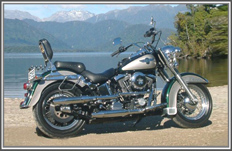
1996 Heritage Special
Nothing that the company had on their line-up, came close to fitting the demands of the 'Super-bike' racing in the 1990's. The Thunderbolt, was the product of a new partnership between Makwonago and Milwaukee in 1994. The steering geometry and chassis wheelbase stayed unchanged, but the riding position became a combination of the cruisers slouch, and the racer's crouch. Harley Davidson was acting as only the engines supplied, (to a company better experienced), in the racing line of machines. The new design, left more of the frame and engine visible. The Thunderbolt used a disc brake with a six-piston caliper, inverted fork, to the shock absorber and carbon fiber air cleaner cover. The oversized muffler allowed some changing of the Sportsters 1200's performance with a horsepower bump to 76 at 5,000 rpm. and matching figures of torque. The production schedule, was set for 300 Thunderbolts for the year. The Buell's weight was 481 pounds.
The S2T was introduced in '96, with color coordinated saddlebags and faring lowers, with touring handlebars and foot-pegs. The S2T was listed for $11,995, with the touring model listing for $11,795, (being right in line with the competition).
The FXRS, had proven to be more popular than the Sport edition, and the two models had become too similar to find need for two separate motorcycles, that were almost identical, and without the saddlebags and windshield, the FXRS was a Sport. With the switch to the Dyna Glide chassis, the Sport was deleted, in favor of the FXDS. The FXDS came with a 81.65 cubic inch displacement , 3.5 x 4.25 inch bore and stroke engine with a compression ratio of 8.5:1 and produced 72 horsepower at 4,000 rpm. The Dyna transition did change some modifications to the sport-touring machine. The steering head angle decreased from 31 to 28 degrees, and the wheelbase lost and inch and became 63.9 inches. The FXDS came with 38mm Kelhim carburetion, 5 speed transmission, duplex chain front, and belt final drive, dual disc front, disc ear disc brakes, with a 12 volt system and CDI ignition. The reduction of the wheelbase gave a quicker handling in tighter turns, and the Dyna had a quarter inch more ground clearance, but was 35 pounds heavier, weighing 638 pounds. The fuel capacity was 4.9 gallon, with a 3 quart oil capacity, 100/90-19 front, and 130/90-16 rear tires. a steel double down-tube frame, telescopic fork, rear shock suspensions, and got a top speed of 112 miles per hour.
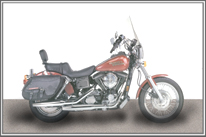
1996 FXDS
With color schemes of slate blue pearl, vivid black, violet pearl, patriot red pearl, two-tone violet/red pearl, and two tone platinum silver/black, there were several color schemes for the rider to choose from. Part of the appeal the FXDS had, was the quick-change of the windshield and saddlebags, which one could detach in just a few minutes. The FXDS sold for $13,330. The change from touring to sport, was a convenience many riders appreciated and took advantage of. The leather top saddlebags had a nylon inner liner and a hard plastic frame to help maintain their shape. The 28 degree fork and longer travel suspension improved handling on the back roads, and came with cast wheels, as standard, though the option was their for those who preferred the laced rims. With the FXRS Low Rider Sport gone, the series dropped down to four models. The FXD Dyna Super Glide, had the Low Riders steering properties, though a slightly less wheelbase, and only one front disc brake. The FXDWG Dyna Wide Glide and Low Rider kept the longer wheelbase and 32-degree fork. The tachometer and speedometer were mounted to the handlebar, and windshield detachment was quick and easy.
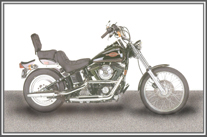
1996 FXSTC
The FXSTC Softail custom saw very few changes in it's five years other than color options and trim, (in the form of graphics). The front fork is raked out at 34 degrees, and a wheelbase of 66.5 inches. Also, was the dropping of the seat height to 26.6 inches. Unlike some of the other machines in the line up, the Softail Custom had lost a few pounds in it's transitions, where other bikes had gained a few pounds. The Custom Softail, bared its resemblance to the original hard tail of the 1950s. The Softail Cutom's weight was 613 pounds, and the laced 21 inch front wheel sets a fair amount in front of the rest of the motorcycle. The highway pegs, and buckhorn handlebars give the effect of the laid back posture and riding position of the feet-first style. The Custom and the Wide Glide still employed 5.2 gallon fuel tanks where the other FX models had the 4.9. The Fat-Boy also shares the disc rear wheel as the Custom. For 1996, the Custom came in patriot red pearl, vivid black, violet pearl, states blue pearl, and two-tone victory sun-glo/platinum, platinum silver/black, and violet/red pearl.

1996 FLSTN
The FLSTN Heritage Softail Special also made the line up into 96, pretty much without change. Like the Springer, the Heritage Softail created it's own fan-fare and following among riders loyal and faithful to the traditional Milwaukee style. The Special was 70 some pounds lighter than the Softail Nostalgia, (in spite of the new Fat-Boy fired-enamel nameplate on the tank, and the seat height was two inches lower, (according to factory specifications). The Specials whitewall tires, 16 inch spoked chrome wheels, with it's subtle two-tone paint schemes in traditional style and fashion, brought back fond memories of the earlier days. Now, complemented by it's oil tight, easy starting, evolution V-Twin in it's hard-tail style chassis, brought the site and sound worthy presence of the Softail prevalence where engineering is forgotten by many, for the pleasure of the ride. The internal improvements for the 1996, included a stronger and quieter transmission, and weather sealed connectors in the wiring system. The electronic speedometer may seem non-consistent with he style of the FLSTN, but the fish-tail-tipped mufflers, and laced leather seat and saddlebags gave a balance in style. The Softail Special's weight was 655 pounds and was listed for $14,655. The evolution engine, solid state ignition, 5 speed transmission, disc brakes, and jumbo headlight bring it's look and style right back into the 1950s. The FLSTN Heritage Softail Special wore just a little more traditional dressings than the Fat-Boy.

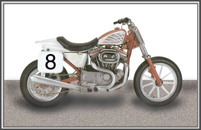
1996 - 883 Twin Sport 1996 - 883Twin Track
The 883 Twin Sports road-racing class featured modified 883 Sportsters, in close competition. Foot-pegs were raised and moved back to provide for the road-racing position. All unnecessary hardware was removed to bring the bikes weight down. The 883 Dirt Track series ran in conjunction with the AMA Grand National Championship races. These machines were fairly modified Sportsters, set up to meet the demands of the half-mile and mile dirt track. These were the two Sportster based production racing divisions; Twin Sports Road-racing and 883 Dirt Track, that the company continued to support. These all-Harley contests serve racers as a semi-pro league, bring the faithful die-hards to the race track, and offer more tangible corporate benefits than Super-bike racing. Harley Davidson placed a tenth at Daytona. New cylinder heads increased the horsepower for the begging 1996 season began.
1996 S and 1996 C
The '96 XL 1200 S came with an engine displacement of 73.2 cubic inch, 3.5 x 3.8 inch bore and stroke, a 9:1 compression ratio, and gave 63 horsepower. It came with a 5 speed transmission, 40mm Kelhin CV carburetion, triple row chain primary, and chain final drive, dual disc front, disc rear brakes, a 12 volt battery and CDI ignition, a steel double down-tube frame, 1.53 inch cartridge fork front, dual gas reservoir shock rear suspensions, a 60 inch wheelbase, weighing 512 pounds. It also came with a 3.3 gallon fuel capacity, a 3 quart oil capacity, 100/90-19 front, and 130/90-16 rear tires, and came in the color schemes of: two-tone violet/red, states blue pearl, vivid black, patriot red pearl, violet pearl; two-tone vctory sun/glo/platinum, and two tone platinum silver/black. The 1200 S got a top speed of 120 miles per hour, and was priced at $7,910.0.
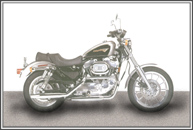
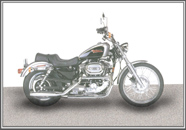
1996 1200 S 1996 1200 C
Through all the improvements and technology, that the bigger machines were getting, some of this attention and the benefits that the larger twins were getting, the smaller Sportsters were getting their part of the benefits as well. Since th4e Sportsters joining the 'evolution' family of machines in '86, belt drives and 5 speed transmissions were standard on both the 883 and the 1200cc models. In 1996, the Sportsters had five of their own models in their own line-up. The standard 883 that came with laced wheels, solo seat, and low handlebar could be had for the price of $5,095.00, the buckhorn-barred 'Hugger' followed with a price tag of $5,760.00. The two newer members to their line-up were the 1200cc Sport and the Custom. The Custom came with a 21 inch wire front wheel, in front, and a 16 inch slotted disc wheel at the rear. An embroidered dual seat came with the Custom, as well as chromed headlights, a fired enamel tank emblem, and handlebar risers. The Custom had a listed price tag of $8,360.00. The XL 1200S 1200 Sportster, which added many extras for those who rode the 1200cc's. All of the 1200's shared with the larger bikes, a common upgrade for 1996; the more efficient high-contact transmission gears, better switchgear and 13 spoke cast wheels, with laced wheels offered as an option. Added by the S model, was an adjustable suspension with gas reservoir shocks and cartridge-type front fork from Showa. Both were adjustable for spring pre-load and compression and rebound damping. Complimenting the new suspension, Harley Davidson fitted the Sportster front wheel with two 11.5 inch floating discs and a re-designed master cylinder. The suspension, brakes and tires gave the Sportster a more comfortable and stable platform at rapid rates on twisty roads. The new braking system, along with Dunlop Sport Elite tires, gave a new energy to the deceleration process. The slowing distance is compressed by better equipment. The XL 1200S Sportster 1200 Sport brought new expectations with it's adjustable suspension at both ends. The Sportster became more sportier. The Sportster Custom had a 21inch spoked front wheel and shorter suspension at both ends. The seat height is almost two inches less than the Sport. The three-dimensional cloisonne tank emblem is unique only to the Custom. The cruiser dress included a black and chrome engine treatment, chrome teardrop headlight, and disc rear wheel. Another dream come true for some of the diehard Sportster fans and riders was, the 3.3 gallon fuel tank. The instruments featured an electronic tach and speedometer with odometer and re-settable trip meter.
With the company introducing it's first fuel-injected tourer with the 30th Anniversary Ultra Classic Electra Glide the previous year, the Weber Marelli Pritzer system was standard on the Ultra Classic Tour Glide and optional for the Classic and Ultra Classic Electras this, the following year.. The fuel injection gave the tourers increases at all speeds. The injected Glides ran clean enough to meet the California emission standards without a catalytic converter. Fuel mileage went up by two miles per gallon in city and country riding. The adoption of the fuel injection was a successful addition to the Electra Glides and added a longer life and service expectancy to it's thirty-one years of service. The two-tone Tour Glide had a $18,160.00 price tag. The Electra Ultra was priced about the same with the addition of the optional fuel injection. The Classic was $14,410.00 with standard carburetion, and $15,210.00 with the fuel injection.
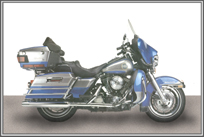
1996 FLHTC UI
The FLHTC UI had an engine displacement of 81.65 cubic inches with a 3.5 x 4.25 inch bore and stroke and a compression ratio of 8.5:1. It's torque was 77 lb-ft at 4,000 rpm. With Electronic carburetion being electronic fuel injection, a 5 speed transmission, duplex chain primary, and belt final drive, it got a top speed of 110 miles per hour. It came with dual Disc front and rear disc brakes, a 12 volt battery, and CDI ignition, a steel double down-tube frame, telescopic fork, shock r4earsuspension, with a wheelbase of 781 pounds, MT90B-16 front and rear tires, a 5 gallon fuel capacity, 4 quart oil capacity, and had the color options of two-tone victory sun-glo/platinum, two-tone mystique green/black, vivid black; states blue pearl, and platinum victory sun-glo. The Ultra Classic Electra Glide had features that couldn't be found on any other bikes on he market of less expense, or size. An 80-watt stereo with weather band, CB radio and standard helmet-mount headset, twin spotlights that operate with the headlight's low beam, and running lights on the front fender and rear luggage, were all part of the FLHTC UI Ultra Classic Electra Glide's included refinements. Air adjustable front and rear suspension, with anti-dive system at the front, to accommodate varying loads and weight on the open road were part of the Ultra Classic's design. The styling of the fairing and luggage changed in only the slightest of ways through the bikes 27 years, and a favorite of loyal Harley Davidson fans since the late sixties. The rider and passenger footboards were also adjustable. The Am/FM/cassette stereo has four speakers, and separate controls for the passenger, and the built-in citizens band radio came with a voice activated intercom with helmet-mounted head-sets. Also as standard equipment, was the electronic cruise control.
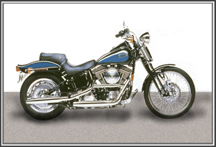
1996 FXSTSB
The FXSTSB, was part of the line up again this year. Introduced the previous year, the Softail Springer with what was called a Bad-Boy attitude, was more black than the chrome this year, and only moderate changes and revisions. It had the 81.65 cubic inch engine displacement, 3.5 x 4.2 bore and stroke, 8.5:1 compression ratio, 76lb-ft torque at 3,500, Kelhin carburetion, 5 speed transmission, CDI ignition, steel dou7ble down-tube frame, disc front and rear brakes, telescopic fork front, and shocks for rear suspension, duplex chain primary, belt final drive, 64.4 inch wheelbase, a 12 volt battery, and got a top speed of 110 miles per hour. The FXSTSB's color options were vivid black with yellow, purple or turquoise graphics. It came with a 4.2 gallon fuel capacity, 3 quart oil capacity, MH90-21 front, and MT90B-16 rear tires. It came with a slotted disc rear wheel of the Custom and a smaller fuel tank. The seat height dropped again to 25.75 inches, and was five pounds lighter.The Softail chassis was changed for more rear wheel travel. Slotted disc brakes and a new quieter hear-box that was smoother-shifting was part of the FXSTSB. A feeling of sitting more 'in' the bike with the weight displacement 'under you, instead of 'on' the bike with the feeling of the weight displacement being the riders responsibility, instead of the bike taking the responsibility of 'carrying' the rider, was a felling many loyal riders shared as a mutual expression. The FXSTSB came with a bullet headlight, black springer front end, and a laced 21 inch front tire. The tank had a polished cloisonne emblem. It came with a studded, deeper, stepped seat and forward-mount controls. Black, was he only color option this year, though choices of yellow, turquoise, or purple, were offered for tank and fender graphics. With the addition of the electronic speedometer, the $13,850.00 price tag went up to $14,425.00 out the door. The FXSTSB was almost identical to the Fat-Boy. It had the lowest seat of the Harleys, and was a leaner machine.
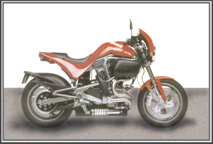
1996 Buell S1 Lightning
Another machine for the 1996's line-up was the Buell S1 Lightning. The Lightning and the Thunderbolt, shared the same chassis, but the lightning was different than the Thunderbolt in most other ways. The S 1 Lightning, had an engine displacement of 73.4 cubic inches, 3.9 x 3.81 inch bore and stroke, with a 10:1 compression ratio and had 91 horsepower at 6,000 rpm. The carburetion was a 40mm Kelhin CV. The S 1 had a 5 speed transmission, triplex chain primary, belt final drive, chrome-moly perimeter frame, 12 volt battery, WP inverted fork front, WP extension adjustable shock rear suspension, CDI ignition, a 55 inch wheelbase and weighed 440 pounds. The S1 had a fuel capacity of 4 gallon fuel, 2.6 quart oil capacity, 120/70-17 front, 170/60-17 rear tires and a top speed of 130 miles per hour, 1,407 of these were built for 1996. Carbon black, high voltage yellow, and red snap were the color options for the bike, and brought a price of $9,995.00. Harley Davidson owned 49 percent interest in Buell Motorcycle Company. The S 1 was sportier than the Thunderbolt and $2,000.00 less expensive. Though they shared the same chassis, one of the differences was the small windshield. The 4 gallon fuel tank was three inches shorter than the Thunderbolts and had a different seat and tail section. The rider was much closer to the handlebars in a more racing position for improved handling. The S2 had a new swing-arm, sub fender, and seat-tail section. At one look, one could see than the Lightning was built for solo riding, was 25 pounds lighter, and 15 horsepower stronger and different in speed and acceleration. Another different was the Thunderbolt air-box, designed to flow more air to the high-performance engine and reduce intake noise. The Thunderbolt rider was put in a more racing-type crouch. The foot-pegs were two inches further back. The 340mm floating rotor is cast iron; the six piston caliper was built for Buell. The cast Marchesini wheels had a titanium finish. The Lightning's fairing barley covered the speedometer and tach. The low tech muffler was enlarged to exhaust spent gases quicker and quietly. With Harley Davidson as a distribution network, partner, and engine supplier, Buell's future in the American Sport bike business, looked positive. The S1 turned a quarter mile under 12 seconds at 114 miles per hour, with a top speed of 130 miles per hour.

1996 FLSTF
The FLSTF had gone pretty much unchanged since it's introduction in 1990. The color scheme of states pearl blue was added as a color option, and the big chrome headlight, and traditional horseshoe oil tank brought reminiscence of years past.
1997
In 1996, a new state of the art Parts and Accessories Distribution Center opened in Franklin, Wisconsin. By the beginning of 1997, all inventory was moved from the original warehouse at Juneau Avenue to the new 250,000 square ft. facility. A new 217,000 square ft. Product Development Center opened next to the Capitol Drive plant in Milwaukee, and the building is dedicated to Willie G. Davidson. Power-train Operations at Capitol Drive expanded its capacity by moving FL engine and transmission production to a newly purchased plant located in Menomonee Falls. XL engines and transmissions, as well as Genuine Pars manufacturing, stayed at Capitol Drive.
Harley Davidson also introduced the Heritage Springer Softail in 1996 - 1997, and the new 330,000 square ft. plant in Kansas City made it's first Sportster.
1998
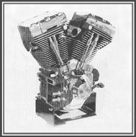
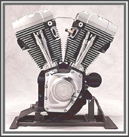
Twin Cam 88
Harley Davidson had their 95th anniversary this year and over 140,000 riders are welcomed into Milwaukee to take part in the celebration. Harley Davidson also buys the remaining 49% interest in the Buell Motorcycle Company. Eric Buell is named Chairman of Buell Operations.
A new Assembly operations facility opens in Manaus, Brazil, the first operations outside the U.S. This brought some international relations when Harley built its first foreign production warehouse.
The Twin Cam 88 engine was released for the 1999 model year on September of 1998 as a successor to the Evolution. The engine design was considerably different from it's predecessor, though it shared some design elements with the Sportster line. The '88' represents the engine displacement of the basic engine in cubic inches, 88 cubic inches being approximately 1450cc. The motor company released a '95 inch' upgrade kit a year later which increased it's displacement to 1550cc. The Twin Cam, wasn't initially used in the Softail model family before the year 2000, because of increased engine vibration and the chassis' design. This being an issue Harley resolved by making a re-designed version of the Twin Cam, the Twin Cam 88B, which basically, was the same original Twin Cam, but with a different engine block design and twin chain-driven counter-balancers, which had caused some controversy among some of the older Harley riders, claiming that the Harley 'vibes' were a part of their motorcycles. The Twin Cam generated a lot more torque and power than the Evolution engine and all it's components were built to tougher standards. Upgrading to 1550cc became a norm among most riders.
When the Twin Cam engine was released, Harley Davidson put a lot of emphasis on what was said to be a stronger case and bottom end. It was claimed that the older Big Twin design, with the cam bearing positioned directly above the main bearing on the right side of the engine, precluded increasing the main bearing size to optimal and created structural weakness in the right side of the case because of the small space between the two bearings. After market companies, however, have used the old design in engines displacing 144 cubic inches (2360cc) and more, successfully, producing well over 120 foot pounds (163Nm) torque and 120 horsepower without case failure, casting doubt on Harley's claims.
The Twin Cam motor has cam chain tensioners with nylon composite shoes. They changed from spring loaded to hydraulically loaded tension on the shoes of the Dyna line for the 2006 model year and for all Twin Cams with the introduction of the 96ci Twin Cam for 2007 model year, as the nylon composite shoes have proven to be a wear item not included on a regular maintenance schedule. Some believe shoe wear and the variability of cam timing introduced by inconsistent tension on cam chain continue to be an issue best resolved by after market gear drive cam sets.
An internal, high efficiency oil pump improves oil flow, as the
oil is filtered before it goes to the engine, ensuring cleaner oil to critical
areas. Cooling jets spray oil under the pistons reducing piston temperature with
pm and load to ensure optimum combustion and power output. Better engine thermal
management due to 50% more fin area and piston cooling jets, stronger crancase,
increased diameter straight crank pin with more bearing area. Reworked exhaust
and intake ports and valves which optimise emissions efficiency and power
output, single-fire ignition system, cool-air intake from new, bigger air
cleaner with front intake opening. In 1999, Harley-Davidson introduced the 88 cu in, twin cam,
electronic fuel injected engine and the Touring and Dyna motorcycle families get
the new Twin Cam 88® engine.
1999

Road-Glide Tourer
Harley Davidson celebrated its 95th anniversary in 1998, and threw another, major party in Milwaukee. The big news was the new engine for 1999. The Twin Cam 88, the number designating cubic inches, with an 8 percent jump in horsepower and 110 percent gain in torque. The rubber mounted big twin was standard in the road glide tourer, with carburetor or optional sequential port fuel injection. The frame mount fairing housed dual oval headlights, heavy-duty wiring harness, and premium stereo sound system.

FLSTS Heritage Springer
The FLSTS Heritage Springer retained the evolution engine, now in its 16th year of production. The styling cues of the forties were enhanced by the fringed leather seat and saddlebags, and traditional paint striping. The color combinations that were offered were red pearl with silver trim, sinister blue pearl with grey, and diamond ice pearl with black trim.
The FX Dyna Glide series included five models for 1999. The Super Glide, the super glide sport, convertible, and wide glide were fitted with twin cam 88 engine. The four FX Softail models retained the Evolution engine. The FXR was revived in 1999, in two limited edition factory customs of 900 each. The process were $17,000 and 18,000.
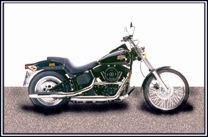
FXSTB Night Train
The FXSTB Night Train was offered with a color choice of vivid black, with a trim seat and drag bars on 6 inch chrome risers. The black on black motif was contrasted by the 16 inch aluminum disc rear wheel, chrome drag pipes, and laced 21 inch front wheel with a single disc brake.
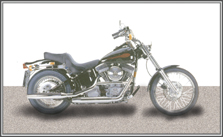
Softail Standard
The Softail Standard was also offered only in vivid black, though without the black engine treatment. The standard engine got a silver powder – coat finish, and the high handlebar was mounted on chrome pull-back risers. A wider custom seat was standard on the Standard, as were laced wheels at both ends. At 635 pounds, this was the lightest of the softail series.
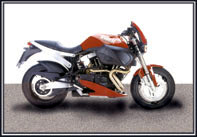
Lightning X1
Buell’s lightning X1 was fitted with Dynamic Digital injection, which monitored atmospheric and temperature conditions inside and outside the 1200cc engine. A fourth heim joint was added to tighten the chassis. The cast aluminum tail section was bolted to a new frame, which permitted tighter routing of the exhaust system. The Lightning was priced $10,599.

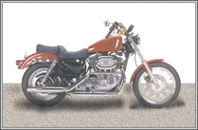
883 Sportster XL Sportster 1200cc XLH
The 883 Sportster was presented in Custom trim for 1999. The disc rear wheel, drag bars and 21-inch front wheel brought a low rider look to the XL. The XLH 1200 wore the traditional buckhorn handlebar and detachable passenger seat for stylish duty in the solo mode.
This year was also the introduction of the "next" generation of Harley engines, the Twin Cam 88 cubic inch motor. With more engineering than ever before, this new breed of engine had the job of proving itself. The first engine with fuel injection, has suffered teething problems, most notably in an under designed clutch assembly. The external twin-geroter oil pump is more efficient and maintains a higher pressure and larger volume. The cams, with 4 lobes, one per cylinder, each with two lobes, allows the push rods to be better aligned with the rocker arms. The ignition system uses single coil. Plugs are 14 mm no waste spark and is a dual coil ignition, air cooled. More cooling fins were used and an oil jet was added to spray the bottom of the pistons.
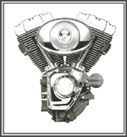
In the year 2001 Fuel injection was available on the Softail models.
Author: Dermage,/Wm.R.G./Webmaster: wm.grett@yahoo.com